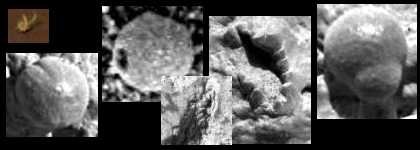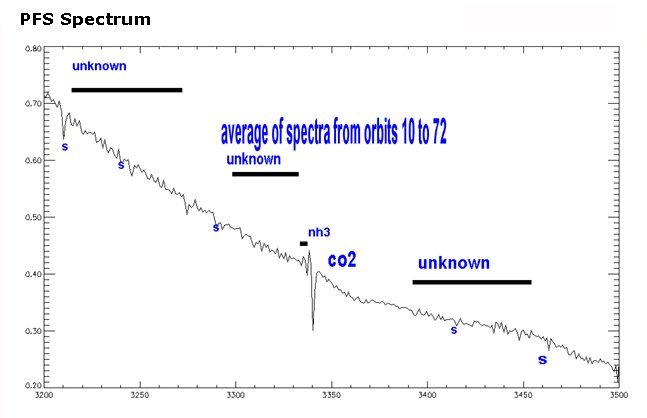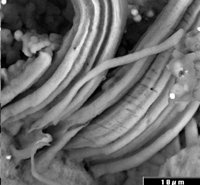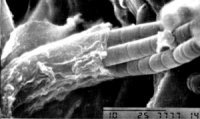Index
• EXTANT LIFE ON MARS
• Formisano/Cottini Ischia abstract 'vents'
• Welcome Coast Listeners
• We Told You So by David Sadler
• Formisano's Twilight Zone by Richard C. Hoagland & David Sadler
• Microfossils in a Carbonaceous Meteorite by Brig Klyce
• A comparison of 'tube-dunes' on Mars
awaiting peer review...
Vittorio Formisano’s & V. Cottini's Ischia Abstract
that all but announces life on Mars ...
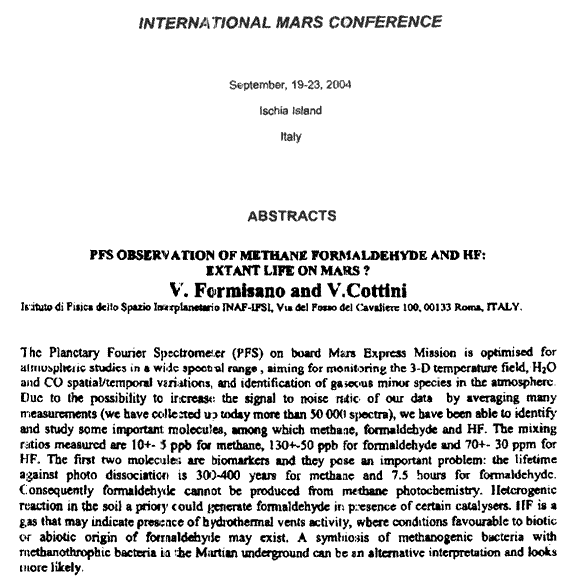
Scanned abstract image above...
Typed from scanned image below ...
INTERNATIONAL MARS CONFERENCE
September, 19, 23, 2004
Ischia Island
Italy
ABSTRACTS
PFS OBSERVATION OF METHANE FORMALDEHYDE AND HF:
EXTANT LIFE ON MARS?
V. Formisano and V. Cottini
Istituto di Fisica dello Spazio Interplanetario INAF-IFSI, [unreadable] Rome, ITALY
The Planetary Fourier Spectrometer (PFS) on board Mars Express Mission is optimised for atmospheric studies in a wide spectral range, aiming for monitoring the 3-D temperature field, H2O and CO spatial/temporal variations, and identification of gaseous minor species in the atmosphere. Due to the possibility to increase the signal to noise ratio of our data by averaging many measurements (we have collected up today more than 50,000 spectra), we have been able to identify and study some important molecules, among which methane, formaldehyde and HF. The mixing ratios measured are 10+- 5 ppb for methane, 130+-50 ppb for formaldehyde and 70+- 30 ppm for HF. The first two molecules are biomarkers and they pose an important problem: the lifetime against photo dissociation is 300-400 years for methane and 7.5 hours for formaldehyde. Consequently formaldehyde cannot be produced from methane photochemistry. Hetcrogenic (sp) reaction in the soil a priory could generate formaldehyde in presence of certain catalysers. HF is a gas that may indicate presence of hydrothermal vents activity, where conditions favourable to biotic or abiotic origin of formaldehyde may exist. A symbiosis of methanogenic bacteria with methanothropic bacteria in the Martian underground can be an alternative interpretation and looks more likely.
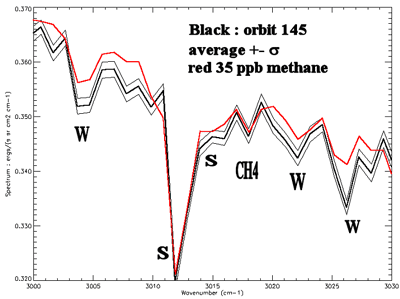
Methane concentration observed and measured by the ESA PFS
Chart copyright ESA
Extracts from:
Water and methane maps overlap on Mars: a new clue?
European Space Agency: ESA PR 51-2004
20 September 2004
Recent analyses of ESA’s Mars Express data reveal that concentrations of water vapour and methane in the atmosphere of Mars significantly overlap. This result, from data obtained by the Planetary Fourier Spectrometer (PFS), gives a boost to understanding of geological and atmospheric processes on Mars, and provides important new hints to evaluate the hypothesis of present life on the Red Planet.
… New in-depth analysis of PFS data also confirms that methane is not uniform in the atmosphere, but concentrated in some areas. The PFS team observed that the areas of highest concentration of methane overlap with the areas where water vapour and underground water ice are also concentrated. This spatial correlation between water vapour and methane seems to point to a common underground source.
… The PFS instrument has also detected traces of other gases in the Martian atmosphere. A report on these is currently under peer review. Further studies will address whether these gases can be linked to water and methane and help answer the unresolved questions.
… The objective of the PFS instrument is the study, with unprecedented spectral resolution, of temperature fields in the atmosphere, dust, variation and cycle of water and carbon monoxide, vertical distribution of water, soil-atmosphere interactions and minor gaseous species. From this, hints of extant life can be extracted (in terms of the presence of ‘biomarker’ gases and chemical study of atmospheric environmental conditions).
• Water and methane maps overlap on Mars: a new clue? // ESA
• European Space Agency
• New Mars Data Gives Life Clue // BBC
• Mars Express Yields Provocative Observations // space.com
• Interview with Vittorio Formisano // Linda Moulton Howe
David Sadler
2004.09.23
HF is a gas that may indicate presence of hydrothermal vents activity, where conditions favourable to biotic or abiotic origin of formaldehyde may exist.
-- PFS OBSERVATION OF METHANE FORMALDEHYDE AND HF: EXTANT LIFE ON MARS?, V. Formisano and V. Cottini, Istituto di Fisica dello Spazio Interplanetario INAF-IFSI, Rome, Italy, INTERNATIONAL MARS CONFERENCE, September, 19, 23, 2004, Ischia Island, Italy --

NASA image: MER Opportunity :: Panoramic Camera :: Sol 183
As one example, such vent or percolation activity is strongly suggested by Mars Exploration Rover (MER) Opportunity :: Panoramic Camera :: Sol 183 [image] [browse].
See this independent argument for this image being evidence of liquid percolation to the surface of Mars. The stereo pair of this image at this site is quite persuasive. Thanks to Ron McGhee for bringing this to our attention.

NASA image: MER Opportunity :: Panoramic Camera :: Sol 138
Another example of recent running liquid leaving the soil wet and showing eddy trailings is from Opportunity's mission to Meridiani Planum, Panoramic Camera :: Sol 138. [image] [browse].
The eddy deposits behind the obstructions indicate a liquid flow from upper-right to lower-left.
The mystery is not whether there is liquid on the surface of Mars, but why it has not been acknowledged by NASA and the 'scientific' press in the face of such evidence.
External links:
• A Perfect Geyser From Opportunity, Sol 183 // xenotechresearch.com // Charles W. Shults III
• Wet Mud In Endurance Crater // xenotechresearch.com, Charles W. Shults III
• Geyser in Action? NASA Altering Images? // xenotechresearch.com, Charles W. Shults III
• Mars geyser plume // by Vince DiPietro, published by Dr. Leonard Martin of Lowell Observatory, 1980, NASA Activities (Dec. 1980, vol. 11, number 12)
• NASA/JPL Rover raw image browsers [Opportunity] [Spirit]
Coast to Coast with George Noory
by David Sadler
2004.09.20
Formisano’s Twilight Zone
Parts One and Two as published on the Enterprise Mission.
My co-author for these articles is Richard C. Hoagland.
Paola Harris had nothing to do with the research and the writing of these two articles.
It was I who developed the high-level source to acquire the first Ischia program showing Formisano’s presentation title to be ‘PFS Observed methane, formaldehyde and HS: Extant life on Mars?’ Even though that program title was changed in the second version of the Italian Space Agency’s posted program, it was still used at Ischia today(!) even though it was not addressed by Formisano during his presentation! I will have more to write about this later.
And, it was I who took the time to look up the meaning of the word ‘extant’ and then analyze the use of that word in Formisano’s Ischia program title.
Yet, George Noory has chosen to ignore inviting the principal author of those pieces onto Coast, to discuss Formisano’s first Ischia program title and now to discuss the political implications of Formisano’s actual Ischia presentation. Instead, I am told for that for the sake of ‘show biz’ a known name such a Paola Harris will better serve the show.
Now Harris is on site in Italy for the IMC making her the go to person for reporting on today's Ischia announcements, so that is not the issue. The issue is that Noory has excluded the principal author of this investigative series from his show, which is his right, but he is wrong to do so.
I do not engage in ‘show biz.’ I am on a search for the truth. I am pursuing an agenda that will bring accountability back to the U.S. government and its agencies including NASA. I am pursuing an agenda that will bring real scientific integrity back to science. And I am pursuing an agenda that will acknowledge what many know from first hand experience and direct experiment --- that there is life off Earth.
Enjoy the show, but remember, the principal author is missing from the line up because he was not a ‘star.’ My question is, what does being a 'star' have to do with COSPAR, Ischia, the race to announce life on Mars and the Formisano’s Twilight Zone articles that helped to build the momentum towards Ischia?
David Sadler
2004.09.20
